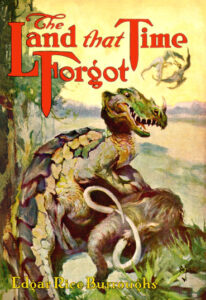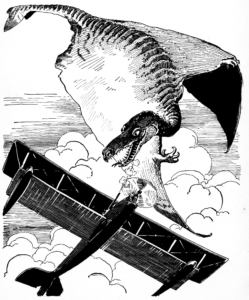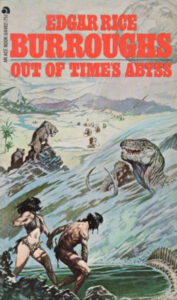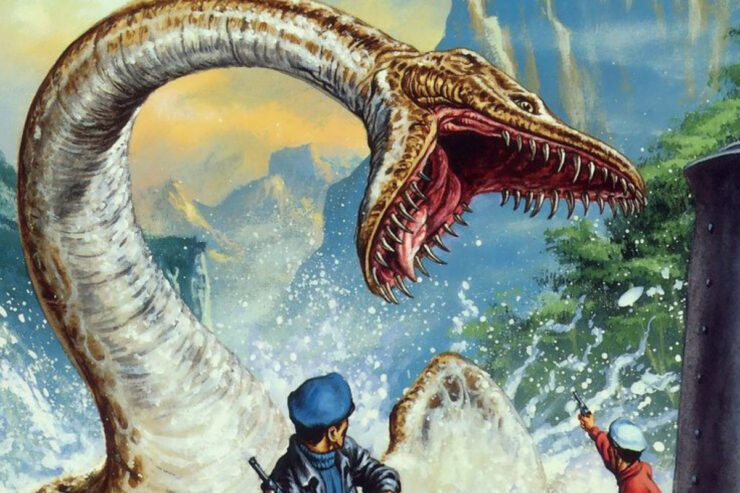 Originally published in 1918 by The Blue Book Magazine, Edgar Rice Burroughs’ The Land That Time Forgot got its start as “The Lost U-Boat.”
Originally published in 1918 by The Blue Book Magazine, Edgar Rice Burroughs’ The Land That Time Forgot got its start as “The Lost U-Boat.”
It’s the story of a submarine, lost in the South Atlantic, that comes upon an island, ringed by towering cliffs. A submerged passageway leads the crew under the cliffs to the land of Caspak. There, primitive human beings live side-by-side with dinosaurs and other creatures of the past. It is truly a “Land That Time Forgot.”
All about us was a flora and a fauna as strange and wonderful to us as might have been those upon a distant planet had we suddenly been miraculously transported through ether to an unknown world. Even the grass upon the nearer bank was unearthly — lush and high it grew, and each blade bore upon its tip a brilliant flower — violet or yellow or carmine or blue — making as gorgeous a sward as human imagination might conceive. And the life! It teemed. The tall, fernlike trees were alive with monkeys, snakes, and lizards. Huge insects hummed and buzzed hither and thither. Mighty forms could be seen moving upon the ground in the thick forest, while the bosom of the river wriggled with living things, and above flapped the wings of gigantic creatures such as we are taught have been extinct through countless ages.
 When “The Lost U-Boat” was finally released to the public, it was entitled “The Land That Time Forgot.” Its initial segment appeared in the August 1918 issue of Blue Book Magazine, its fantastic content masked by one of Hamilton King’s attractive portraits of a young woman. It was followed soon thereafter by “The People That Time Forgot,” featured in the October 1918 number, and “Out of Time’s Abyss,” published in its entirety in the December 1918 issue of The Blue Book Magazine. Once again, portraits of young women — the first by Z. P. Nikolaki and the second by M. S. Musselman — adorned both issues.
When “The Lost U-Boat” was finally released to the public, it was entitled “The Land That Time Forgot.” Its initial segment appeared in the August 1918 issue of Blue Book Magazine, its fantastic content masked by one of Hamilton King’s attractive portraits of a young woman. It was followed soon thereafter by “The People That Time Forgot,” featured in the October 1918 number, and “Out of Time’s Abyss,” published in its entirety in the December 1918 issue of The Blue Book Magazine. Once again, portraits of young women — the first by Z. P. Nikolaki and the second by M. S. Musselman — adorned both issues.
Burroughs’ fantastic trilogy concerns a land where individuals — both animal and human — seem to evolve over their lifetimes, advancing in stages until each reaches its proper evolutionary niche. A tale of action, romance, and adventure, Edgar Rice Burroughs gradually tackles the subject of evolution, in bits and pieces scattered throughout the three novellas.
. . . I decided that it was a sort of original religious conviction, as much a part of them as their instinct for self-preservation — a primal acceptance of a hereafter and a holier state. It was a brilliant theory, but it was all wrong. I know it now, and how far we were from guessing the wonderful, the miraculous, the gigantic truth which even yet I may only guess at — the thing that sets Caspak apart from all the rest of the world far more definitely than her isolated geographic position or her impregnable barrier of giant cliffs. If I could live to return to civilization, I should have meat for the clergy and the layman to chew upon for years — and for the evolutionists, too.
At the time of the trilogy’s original publication, Christian fundamentalists led a growing resistance against teaching evolution in schools. By 1925, legislation prohibiting instruction in evolutionary theory was being considered in 15 states and had passed in some, including Tennessee and Mississippi. The American Civil Liberties Union offered to defend anyone who wanted to challenge these laws. This led to the well-known “Scopes Monkey Trial,” in which William Jennings Bryan, a former congressman and evangelical Protestant, argued that the theory of evolution contradicted the biblical account of creation.
From the egg, then, the individual developed slowly into a higher form, just as the frog’s egg develops through various stages from a fish with gills to a frog with lungs. . . . From the ape the individual, if it survived, slowly developed into the lowest order of man — the Alu — and then by degrees to Bo-lu, Sto-lu, Band-lu, Kro-lu and finally Galu. And in each stage, countless millions of other eggs were deposited in the warm pools of the various races and floated down to the great sea to go through a similar process of evolution outside the womb as develops our own young within; but in Caspak the scheme is much more inclusive, for it combines not only individual development but the evolution of species and genera. If an egg survives it goes through all the stages of development that man has passed through during the unthinkable eons since life first moved upon the earth’s face.
 Almost six years after its debut in Blue Book, Edgar Rice Burroughs gathered his three novellas together and offered them to A. C. McClurg for book publication. McClurg’s first edition of The Land That Time Forgot — featuring dust jacket and interior art by the great J. Allen St. John — was released in June 1924. A year later, William Jennings Bryan was challenging the theory of evolution in America’s courts of law.
Almost six years after its debut in Blue Book, Edgar Rice Burroughs gathered his three novellas together and offered them to A. C. McClurg for book publication. McClurg’s first edition of The Land That Time Forgot — featuring dust jacket and interior art by the great J. Allen St. John — was released in June 1924. A year later, William Jennings Bryan was challenging the theory of evolution in America’s courts of law.
At PulpFest 2024, we’ll not only celebrate “Spice, Spies, Shaw, and More,” we’ll salute the centennial of the first book publication of Burroughs’ The Land That Time Forgot (as well as the fiftieth anniversary of the film of the same title). It’s part of our third iteration of ERBFest, a convention within PulpFest that honors the Master of Romance and Adventure, Edgar Rice Burroughs.
ERBFest 2024 will be co-hosted by Henry G. Franke III — the editor of The Burroughs Bibliophiles, which publishes The Burroughs Bulletin journal and The Gridley Wave monthly newsletter. We’ll have a film program and presentations on “Pulp Paleontology” and “The Women of Edgar Rice Burroughs,” as well as a panel presentation by Edgar Rice Burroughs, Inc. All this and more will be part of ERBFest 2024.
 Of special note is the 2024 Dum-Dum Banquet, scheduled for Saturday, August 3, starting at 5:30 p.m. at the Bravo! Italian Kitchen, located one-half mile from PulpFest’s host hotel. The banquet will be hosted by The Burroughs Bibliophiles and is independent of PulpFest 2024.
Of special note is the 2024 Dum-Dum Banquet, scheduled for Saturday, August 3, starting at 5:30 p.m. at the Bravo! Italian Kitchen, located one-half mile from PulpFest’s host hotel. The banquet will be hosted by The Burroughs Bibliophiles and is independent of PulpFest 2024.
So be sure to join us August 1 – 4 at the DoubleTree by Hilton Hotel Pittsburgh – Cranberry in Mars, Pennsylvania.
The general public is welcome to attend our evening programming events free of charge. To learn more about our programming, please click the Schedule button at the top of this page.
For those who also want to enjoy our dealers’ room, you can join PulpFest by clicking the registration button at the top of this page. And don’t forget to book a room at the DoubleTree. They’re going fast!
If you want to sell at this year’s PulpFest, our wall tables are sold out. Island tables are still available, but they won’t last long. Register soon!
Our featured image is excerpted from Joe Jusko’s The Land That Time Forgot art used on the cover for the Edgar Rice Burroughs omnibus volume, Savage Epics, published in 2023 by Edgar Rice Burroughs, Inc.
Our lead image is J. Allen St. John’s dust jacket for the 1924 A. C. McClurg edition of The Land That Time Forgot, Edgar Rice Burroughs’ book version of the Caspak trilogy.
Frank R. Paul’s interior illustration was created for “The People That Time Forgot,” the second segment of Edgar Rice Burroughs’ The Land That Time Forgot trilogy. Paul’s illustration originally appeared in the March 1927 issue of Amazing Stories, published by Hugo Gernsback’s Experimenter Publishing Company.
Our third image is Frank Frazetta’s cover for the third Ace Books printing of Edgar Rice Burroughs’ Out of Time’s Abyss, published in 1973. It’s the concluding segment of the author’s The Land That Time Forgot trilogy.
Our final image is the logo saluting the centennial of The Land That Time Forgot, created by Mike Wolfer for Edgar Rice Burroughs, Inc. It is copyright © 2024 by Edgar Rice Burroughs, Inc. and a registered trademark ®. Mike Wolfer is currently writing a novel for ERB, Inc., entitled The Land That Time Forgot: Fortress Primeval.
Derek Starr is a writer and popular culture enthusiast who began contributing to our website in 2022. He particularly enjoys the Fiction House pulps. One of his favorites is Planet Stories, the publisher’s legendary science fiction pulp.
For more on Edgar Rice Burroughs and his work, check out our YouTube channel . . .
And while you’re there, please be sure to subscribe.
Trademarks Tarzan®, Tarzan of the Apes®, Jane Porter®, La of Opar™, Opar™, John Carter®, Dejah Thoris®, Tara of Helium™, Barsoom®, Chessmen of Mars™, Pellucidar®, At the Earth’s Core™, David Innes™, Dian the Beautiful™, The Land That Time Forgot®, Edgar Rice Burroughs®, Master of Adventure™, and others owned by Edgar Rice Burroughs, Inc. Associated logos, characters, names, and the distinctive likenesses thereof are trademarks or registered trademarks of Edgar Rice Burroughs, Inc. Used by Permission.







